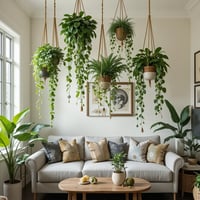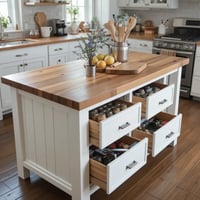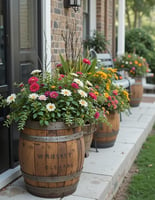You know that feeling when you walk into someone's home and immediately think, "Wow, this place has...
15 Landscape Design Ideas That Will Instantly Elevate Your Outdoor Space
Disclosure: This post contains affiliate links which means I may receive a small commission at no extra cost to you!
Let’s face it—your outdoor space deserves more than a patchy lawn and a couple of sad planters. Whether you’ve got a small backyard, a sprawling lawn, or just a front yard waiting to make a first impression, the right landscape design can completely change the game. The good news? You don’t need a massive budget or a team of designers to create a space that feels intentional, relaxing, and maybe even a little show-off worthy. It’s all about choosing the right ideas and putting them to work with smart, doable steps.
Below, I’ve rounded up 15 landscape design ideas, counted down from bold to basic (but still beautiful). Each one comes with a quick explanation to help you picture how it might work in your own yard. Whether you’re starting from scratch or just tweaking what you’ve already got, you’ll find something here to spark inspiration—and action.
15. Add a Fire Pit Lounge Area

There’s something primal and powerful about gathering around fire—and your backyard should have that magic. A fire pit lounge is perfect for cool evenings, roasting marshmallows, or sipping wine under the stars. Choose between a built-in stone pit or a sleek portable option, and surround it with comfy seating like Adirondack chairs or weatherproof sectionals. Pro tip: Use gravel or pavers underneath for a defined and fire-safe zone. This one upgrade turns your yard into a year-round hangout spot.
14. Layer Your Lighting

Lighting isn't just for safety—it’s a mood-setter. Think beyond the single porch light and get creative with layers: string lights, solar path markers, uplighting for trees, and lanterns. Well-placed lights can highlight your garden’s best features and make your space feel larger at night. Plus, it makes nighttime BBQs or evening strolls feel way more special. Bonus: Low-voltage or solar options keep things energy-efficient.
13. Create a Backyard Dining Zone

Alfresco dining never goes out of style—and designing a space specifically for outdoor meals makes a difference. Start with a level surface like a stone patio or wood deck. Add a dining table that suits your household size, and consider overhead shade like a pergola or large umbrella. To elevate the vibe, add an outdoor rug and weather-resistant decor. Suddenly, every dinner feels like an occasion.
12. Build Raised Garden Beds

Whether you want to grow veggies, herbs, or just flowers, raised beds are practical and polished. They give structure to your garden, reduce weed issues, and are easier on your back when planting or harvesting. Use cedar wood, bricks, or even galvanized metal for a modern look. Line them up neatly, or create curved patterns for a more organic design. Plus, they help keep critters at bay better than in-ground beds.
11. Mix Hardscape with Softscape

A truly balanced yard needs more than just plants. Hardscaping (like stone, wood, or concrete) adds structure and contrast to all that greenery. Think stepping stones cutting through grass, gravel paths beside lush flower beds, or a wooden deck surrounded by ferns. The contrast of textures makes a space feel dynamic and well thought out. Too much of one or the other, and it all starts to feel flat.
10. Install a Water Feature

There’s something about the sound of trickling water that instantly relaxes the mind. Even if you don’t have space for a pond or waterfall, smaller options like a ceramic fountain or wall-mounted spout can still deliver serenity. Choose a spot near a seating area for max impact. Not only does it look beautiful, but the sound also helps mask neighborhood noise—ideal if you live near traffic. Nature sounds without needing a nature hike? Yes, please.
9. Add Vertical Gardens or Green Walls

Short on space? Go up. Vertical gardens use fences, walls, or freestanding frames to grow herbs, flowers, or even succulents. They're great for balconies, patios, or tight yards where you want greenery without eating up floor space. Plus, they double as privacy screens or focal points. Try hanging planters, modular panels, or even repurposed pallets for a DIY approach.
8. Embrace Native Plants

Native plants are the unsung heroes of low-maintenance landscaping. They’re adapted to your region’s soil, climate, and wildlife, which means less watering, fertilizing, and stressing. Plus, they attract pollinators and promote biodiversity—your local bees and butterflies will thank you. Work with a local nursery to find out what thrives in your area. Going native doesn’t mean boring—it means smarter choices with real staying power.
7. Define Zones with Edging

Sometimes, it’s the subtle borders that bring a yard together. Use edging to separate flower beds from lawns, walkways from planting zones, or gravel from grass. Materials like metal, brick, stone, or even crisp wooden edges give everything a clean, intentional look. It’s one of those details people might not notice immediately, but they’ll definitely feel the difference. A well-edged yard just looks more finished.
6. Use Gravel Paths for Texture and Flow

Gravel is having a moment, and it’s not hard to see why. It’s affordable, easy to install, and adds rustic charm to any space. Use it to create winding garden paths or define seating zones. Bonus: It allows for good drainage, which helps in rainy seasons. Choose contrasting colors to make your greenery pop and lead the eye through your space.
5. Install Outdoor Seating Nooks

It doesn’t have to be a full patio—sometimes, just a small bench under a tree becomes your favorite spot. Build mini zones for quiet morning coffee, afternoon reading, or watching the kids play. Think bistro chairs on a gravel patch or a hammock under string lights. These nooks make the space more inviting and livable. The key is to design for moments, not just looks.
4. Play with Plant Heights and Textures

Flat planting is boring. Instead, layer your plants—tall grasses in the back, mid-height shrubs in the middle, and low flowers or groundcover in the front. Mixing textures and leaf shapes adds interest even before anything blooms. It’s like composing a painting with depth and rhythm. Plus, it makes smaller spaces look fuller and more lush.
3. Incorporate Outdoor Art or Sculptures

Your yard isn’t just for plants—it’s also a canvas. Sculptures, wind chimes, mosaic stepping stones, or hanging art can inject personality into the landscape. Just one bold piece can become a focal point or conversation starter. Choose weather-resistant materials and consider scale—too small and it disappears, too big and it overwhelms. Art belongs outside too—let it reflect you.
2. Keep a Consistent Color Palette

Design works best when there’s a plan. Choose a color palette—whether that’s cool tones like blues and purples, or warm bursts of reds and oranges—and stick to it across flowers, pots, and decor. This helps everything feel cohesive, even if the plants change with the seasons. Don’t forget hardscape and furniture colors too—they all play a part. A consistent color theme brings harmony to the whole yard.
1. Start with a Focal Point

Every great landscape design starts with a visual anchor—the first thing your eye lands on. This could be a tree, sculpture, water feature, or even a bold plant like a Japanese maple. From there, design outward: let paths, beds, and seating areas flow naturally from that central piece. A strong focal point gives your yard direction and balance. Without it, things can feel scattered, no matter how pretty.
Final Thoughts
You don’t need a degree in landscape architecture to create an outdoor space that feels beautiful and functional. Start with one or two ideas that fit your lifestyle, and build from there. Think about how you actually use the space—then design for that. And remember: the best landscape is one that works for you, not just the neighbors driving by. Happy planting!





